HOW IS IT INSTALLED?
How is the technology applied? How is Normalizer installed?
The normalizer can be installed at any point in the electrical network, following the electricity meter. Its ap-plication will be evident in the meter readings.
Digital intelligent devices, such as electricity normalizers, are designed to control electricity flow and protect electrical equipment within 0.4 kV networks. With individual unit capacities ranging from 35 kVA to 800 kVA, these normalizers can be connected in parallel to safeguard various types of equipment, including buildings, structures, electrical devices, street lighting, and complexes of buildings.
- Examples of Normalizer installations.
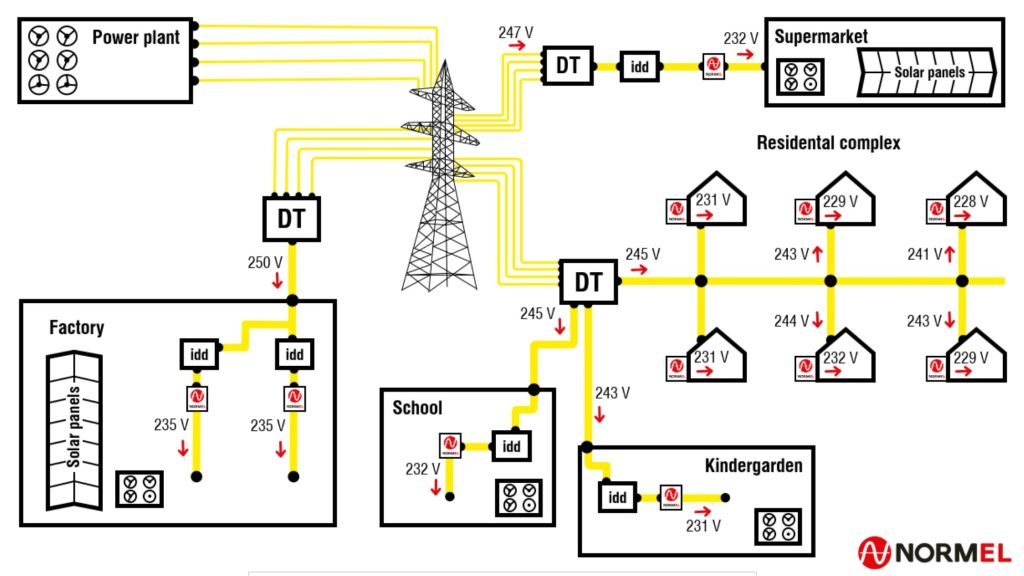
Installation inside a factory – detailed example
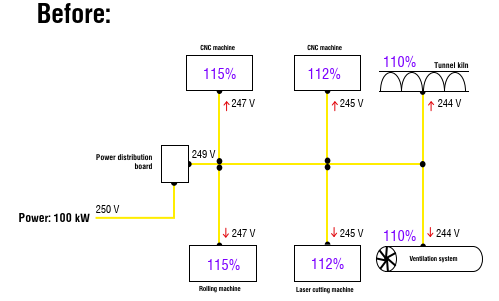
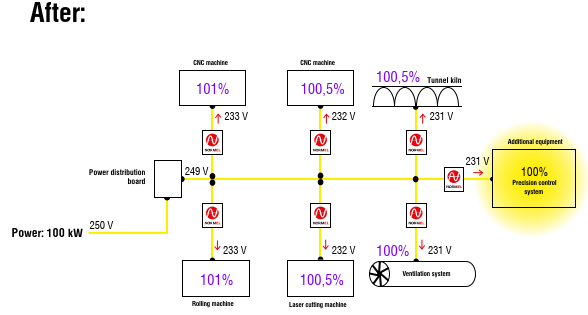
Installation inside a building
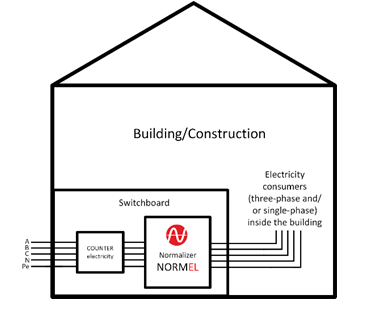
Normalizer in the power grid
When using a normslzer, the higher the voltage in the network, the higher the savings
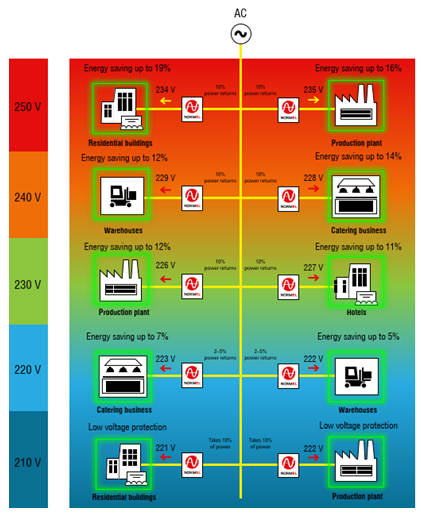
Where is Normalizer applicable?
We have over 20 years of operations with more than 300 clients from completely different industries and scales.
Industrial organizations have reported an average electricity savings of 11.6% to 21.2% due to the imple-mentation of the Normalizer. Here are some examples of companies that have experienced these benefits:
1. Company: A manufacturer of nanostructured ceramics for industrial consumers in energy, radio elec-tronics, mechanical engineering, chemical, and petrochemical industries.
Results: Prevention of defects in medical ceramic implants production due to supply network error in the hot isostatic press.
2. Company: A brewery specializing in the production and bottling of beer and non-alcoholic products.
Results: Complete elimination of power failures in electronic equipment and an 18.5% reduction in electricity costs at mixed load.
3. Company: A business engaged in the production and installation of commercial and office furniture, input systems.
Results: A 19.5% reduction in electricity costs with a mixed load.
4. Company: A provider of complex automation services for trade and production companies, and pro-duction and sales of label, packaging, printing products, and consumables.
Results: A 21.2% reduction in electricity consumption.
5. Company: A mining corporation developing deposits of ferruginous quartzite.
Results: A 11.6% reduction in electric power consumption; effective elimination of pulse oscillations and voltage drops when starting dredgers with a capacity of 3150 kW.
6. Company: The largest integrated zinc producer with a significant share of associated copper, precious metals, and lead output.
Results: A 12.7% average monthly energy savings when applied to ceiling lighting; complete elimi-nation of equipment failure and protection against overvoltage in industrial power grids.
7. Company: An industrial installation and construction enterprise performing construction and electri-cal installation work at facilities of the energy corporation.
Results: Complete elimination of failures in the operation of CNC machines.
8. Company: A comprehensive aviation enterprise responsible for design, manufacturing, sales, maintenance, and repair of aircrafts.
Results: Elimination of power failures in production process control systems for vibration testing of parts and assemblies, and normalization of the technological vibration system.
Medical organizations achieve an average electricity savings of 10% to 18.5%. Here are some examples of companies that have experienced these benefits:
1. Company: Cardiology Research Center – This center specializes in high-tech treatments for coronary heart disease, chronic heart failure, and cardiac arrhythmias.
Results: Elimination of power outages, stable performance of electronic control systems for connected medical equipment, and extended service life of artificial lighting devices.
Results: Lowering of supply voltage levels by 12-16 V, decreased current consumption, and a reduction in electrical power consumption by 10-11%.
Commercial organizations achieve an average electricity savings of 9.8% to 18.9%. Here are some examples of companies that have experienced these benefits:
1. Company: The largest Russian chain of grocery “stores at home”
Results: Elimination of pulse fluctuations in mains voltage, reduced failure rates of electronic components in refrigeration, computer equipment, and lighting devices.
2. Company: The group of companies includes 7 grocery hypermarkets and 60 "home store" format su-permarkets, a furniture showroom with over 10,000 m2, more than 20 branches for wardrobe, kitch-en, and other furniture sales, as well as furniture production workshops and commercial real estate.
Results: 18.9% reduction in electricity consumption and an 85% decrease in the number of replace-ment lighting lamps.
3. Company: The Trade and Exhibition Complex offers an extensive selection of construction and fin-ishing materials, furniture, and interior items across three trade and exhibition buildings and two trade and warehouse buildings.
Results: 14.8% reduction in electricity consumption, 95% decrease in lighting lamp replacements, and 50% reduction in reactive power.
4. Company: The Group of Companies is one of the largest car dealers and importers, established in 1991, and has become a leader in the automotive market.
Results: 9.6% reduction in electricity consumption and a decrease in reactive power by up to 60%.
5. Company: Hypermarket, one of the representatives of the world's largest retail chain operator, founded by a French corporation in 1961.
Results: 14% reduction in electricity consumption, 50% reduction in reactive power, 18% decrease in supply network current load, and a 90% decrease in the number of lighting lamp replacements.
Municipal buildings achieve an average electricity savings of 5.2% to 15%. Here are some examples of companies that have experienced these benefits:
1. Company: Municipal Unitary Enterprise – Specializes in the construction, reconstruction, and modernization of heating networks, TSTP, and gas distribution systems.
Results: 15% average decrease in electrical power consumption, an 85% reduction in TSC equipment accident rates, increased equipment lifespan, and a more than twofold increase in the TSC reconstruction interval.
2. Company: Village Council Administration
Results: Uninterrupted operation of well pumping equipment and gas boiler automatic control and regulation systems, with input voltage levels rising from 197-201 V to 209-213 V, resulting in a com-plete cessation of power failures in control systems.
3. Company: City Water Utility - Established in the municipal economy system in November 1926, ensuring continuous operation of water pipes and sewers.
Results: 5.2% reduction in electricity consumption.
4. Company: Palace of Culture
Results: Over 10% energy savings, complete absence of power failures, and normalization of elec-trical equipment.
5. Company: Regional Water Utility - An essential part of the water supply and sewerage infrastruc-ture.
Results: Use of the product on deep pumps led to a 6% reduction in electricity consumption, a 3% decrease in supply network current load, and enhanced pump protection from external network influ-ences.
6. Company: State Energy Enterprise - Provides reliable and high-quality power supply to residents, housing and communal services, social sphere, and industrial consumers.
Results: 12.7% reduction in electricity consumption
Financial organizations achieve an average electricity savings of 9.6% to 13.3%. Here are some examples of companies that have experienced these benefits:
Company: Public Joint Stock Company “Bank” – Accounts for one-third of the country’s banking system.
Results:
Bank 1 – By eliminating voltage drawdowns and pulse fluctuations in the mains, equipment shutdowns ceased, the number of electronic component failures decreased, and a 13.3% reduction in electricity consumption was recorded.
Bank 2 – Up to 9.6% reduction in electricity consumption with mixed variable loads.
Energy transmission organizations supply consumers with high-quality electricity. Here are some examples of companies that have experienced these benefits:
Company: Regional Electric Networks company – Specializes in the transmission and distribution of electrical energy.
Results: Ensuring the quality of electricity at the sites of the City Electric Networks branch meets the applicable standards, providing consumers with high-quality electricity. It is recommended to implement additional equipment in 0.4 kV distribution networks for further improvements.
Educational buildings achieve an average electricity savings of 17% to 20%. Here are some examples of companies that have experienced these benefits:
1. Company: University (management) – This specialized higher education institution provides training, retraining, and advanced training for state and municipal employees.
Results: 17% reduction in electricity consumption, with stable operation of computer equipment and lighting systems.
2. Company: The Regional Scientific Library - Established in 1926, it holds a prestigious position within the national library community.
Results: 20% reduction in average monthly electricity consumption, and a threefold decrease in the number of lighting replacements.
Entertainment organizations achieve an average electricity savings of 12%. Here are some examples of companies that have experienced these benefits:
Company: Planetarium
Results: Elimination of frequent repairs of electronic components in the audio and video reproduction system of projection equipment, enhancement of equipment stability during full-cycle film production, and a 12% reduction in average monthly electricity consumption and lighting systems.
Transport organizations achieve an average electricity savings of 13.6% to 17%. Here are some examples of companies that have experienced these benefits:
1. Company: The metro, one of the main types of public urban passenger transport and the easternmost metro in the country.
Results: 17% reduction in electricity consumption costs for the engineering building and normalization of the supply voltage of the network.
2. Company: National railways, ranking among the world's top three railway companies, serves as a vital link in the unified economic system, ensures stable operation of industrial enterprises, and remains the most affordable transport option for millions of citizens.
Results: Device application at the station's communication house led to a 13.6% reduction in electric-ity consumption and a decrease in load current; application at the company's facilities resulted in a 15.8% reduction in electricity consumption and a 30% decrease in lamp replacement cases for lighting devices.
Food processing industries achieve an average electricity savings of 13.7% to 16%. Here are some examples of companies that have experienced these benefits:
1. Company: Central Market – A multidisciplinary covered market founded in the 1930s, occupying an area of 2.7 hectares.
Results: An immediate 16% reduction in electricity consumption was recorded.
2. Company: Regional broiler production company - Established in 1977, it is specialized enterprise for the production and processing of broiler chicken meat in its region.
Results: 13.7% reduction in electricity costs with a mixed load.
Sports centers achieve an average electricity savings of 14%. Here are some examples of companies that have experienced these benefits:
Company: The sports complex, a unique multifunctional sports and entertainment facility, is consid-ered a landmark of its city and was built for the XXII Olympic Games in 1980.
Results: 14% reduction in electricity consumption.